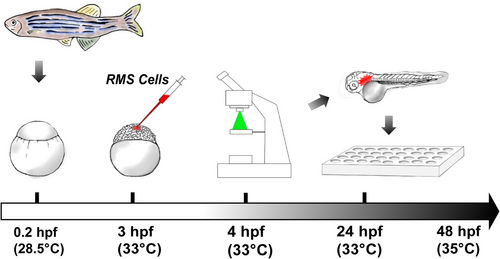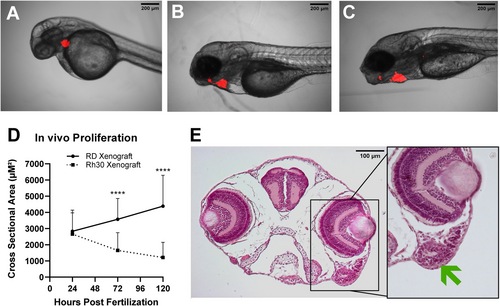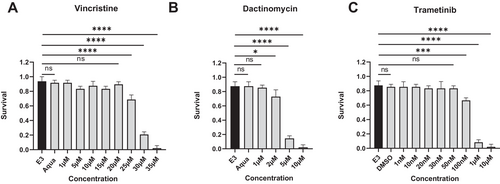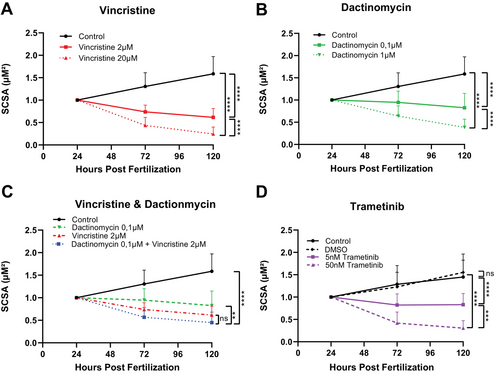- Title
-
Rhabdomyosarcoma xenotransplants in zebrafish embryos
- Authors
- Siebert, J., Schneider, M., Reuter-Schmitt, D., Würtemberger, J., Neubüser, A., Driever, W., Hettmer, S., Kapp, F.G.
- Source
- Full text @ Pediatr Blood Cancer
|
(A) The survival rate of zebrafish embryos at different environmental temperatures was examined during the first 120 hpf. Larvae maintained continuously at 35°C showed lower survival rates compared with the control group kept at 28.5°C. In contrast, embryos maintained at 33–35°C exhibited similar survival compared with the control group. In parallel experiments, the development of (B) RD cells and (C) Rh30 cells was evaluated using the same temperature conditions. (B) RD cell numbers did not differ significantly at lower temperatures compared with control cells maintained at standard temperatures. (C) Rh30 cell numbers counted at 120 h were significant lower when cells were maintained at lower temperatures |
|
Transplantation procedure: fertilized eggs were maintained at 28.5°C until 3 hpf. RMS cells were injected into the blastoderm of 1k-cell to high stage zebrafish embryos, and environmental temperature was raised to 33°C. Embryos were screened at 4 hpf for successful transplantation. The embryos then were transferred to 24 well plates. Maintenance temperature was raised to 35°C at 48 hpf until the end of the experiments |
|
Development of RMS xenografts, derived from RD cells, is depicted at (A) 24 hpf, (B) 72 hpf and (C) 120 hpf. (D) The development of RD and Rh30 cells xenotransplants was observed until 120 hpf. The SCSA of RD tumors increased, whereas the SCSA of Rh30 tumors decreased during the observation period. (E) The head of a xenotransplanted zebrafish embryo was sectioned and stained with hematoxylin and eosin. The arrow marks a nest of tumor cells |
|
Toxic effects of vincristine, dactinomycin, and trametinib were screened in zebrafish embryos. Embryos tolerated exposure to (A) vincristine up to concentrations of 20 μmol/l, (B) dactinomycin up to concentrations up to 2 μmol/l, and (C) trametinib up to concentrations of 50 nmol/l |
|
The anti-RMS effects of candidate chemicals on RD xenografts in zebrafish embryos. (A) Vincristine reduced the SCSA at concentrations of 2 and 20 μmol/l, respectively. (B) Dactinomycin exhibited analogous anti-RMS effects compared with vincristine. (C) Vincristine and dactinomycin in combination did not show stronger anti-RMS effects compared with vincristine alone but had stronger inhibiting effects compared with dactinomycin alone. (D) The MEK-inhibitor trametinib also exerted dose-depending anti-RMS effects in vivo |





